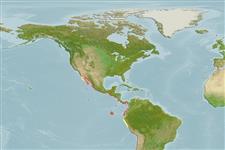Environment: milieu / climate zone / depth range / distribution range
Ecologia
marino; salmastro; distribuzione batimetrica 0 - 50 m (Ref. 188), usually 1 - 7 m (Ref. 96339). Tropical; 33°N - 17°S, 115°W - 76°W (Ref. 188)
Eastern Pacific: La Jolla, California to Peru (at least to Callao), including the Gulf of California (Ref. 35601). (This species seems to have two forms or subspecies: Harengula thrissina thrissina from the Gulf of California to Panama and Harengula thrissina peruana from Panama to Peru).
Size / Peso / Age
Maturity: Lm ? range ? - ? cm
Max length : 18.4 cm TL maschio/sesso non determinato; (Ref. 96339); common length : 8.0 cm SL maschio/sesso non determinato; (Ref. 9291)
Spine dorsali (totale): 0; Raggi dorsali molli (totale): 13-21; Spine anali 0; Raggi anali molli: 15 - 17. tooth plate on tongue and tooth plate behind it (basihyal and basibranchial tooth plates) broad, their width about 3 to 5 times in their combined lengths. Last dorsal fin ray not elongate (cf. Opisthonema).
A schooling species found in coastal waters. Form dense schools along shores and estuarine areas with salinities slightly lower than that of saltwater (Ref. 9291). Feed on planktonic crustaceans (Ref. 9291). Oviparous, with planktonic eggs and larvae (Ref. 35601). Utilized as bait (at least in Mexico and Costa Rica) (Ref. 9291).
Life cycle and mating behavior
Maturità | Riproduzione | Deposizione | Uova | Fecundity | Larve
Whitehead, P.J.P., 1985. FAO Species Catalogue. Vol. 7. Clupeoid fishes of the world (suborder Clupeoidei). An annotated and illustrated catalogue of the herrings, sardines, pilchards, sprats, shads, anchovies and wolf-herrings. FAO Fish. Synop. 125(7/1):1-303. Rome: FAO. (Ref. 188)
IUCN Red List Status (Ref. 130435)
Threat to humans
Harmless
Human uses
Pesca: pesca di sussistenza; esca: occasionally
Informazioni ulteriori
BibliografiaAcquacolturaProfilo di acquacolturaVarietàGeneticaElectrophoresesEreditarietàMalattieElaborazioneNutrientsMass conversion
CollaboratoriImmaginiStamps, Coins Misc.SuoniCiguateraVelocitàModalità di nuotoArea branchialeOtolithsCervelliVista
Strumenti
Special reports
Download XML
Fonti Internet
Estimates based on models
Preferred temperature (Ref.
123201): 22.3 - 29.1, mean 26.4 °C (based on 242 cells).
Phylogenetic diversity index (Ref.
82804): PD
50 = 0.5625 [Uniqueness, from 0.5 = low to 2.0 = high].
Bayesian length-weight: a=0.00912 (0.00433 - 0.01920), b=3.04 (2.87 - 3.21), in cm total length, based on LWR estimates for this (Sub)family-body shape (Ref.
93245).
Trophic level (Ref.
69278): 3.1 ±0.30 se; based on food items.
Resilienza (Ref.
120179): Alto, tempo minimo di raddoppiamento della popolazione meno di 15 mesi (Preliminary K or Fecundity.).
Fishing Vulnerability (Ref.
59153): Low vulnerability (10 of 100).
Nutrients (Ref.
124155): Calcium = 267 [139, 488] mg/100g; Iron = 2.19 [1.33, 3.63] mg/100g; Protein = 18.9 [17.8, 19.9] %; Omega3 = 0.434 [0.246, 0.764] g/100g; Selenium = 39.8 [19.8, 76.8] μg/100g; VitaminA = 31 [14, 71] μg/100g; Zinc = 1.87 [1.31, 2.71] mg/100g (wet weight);
